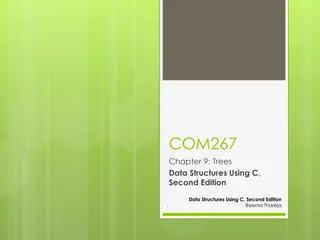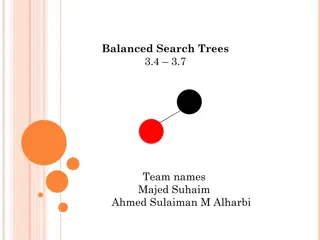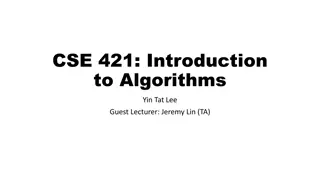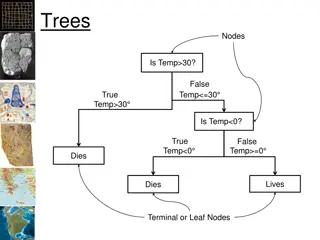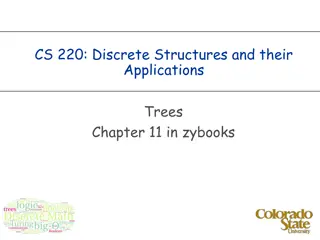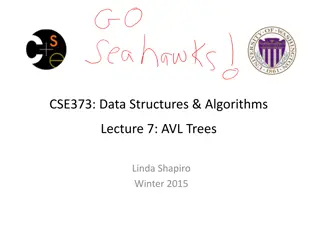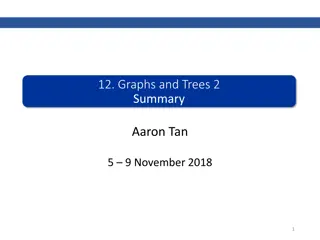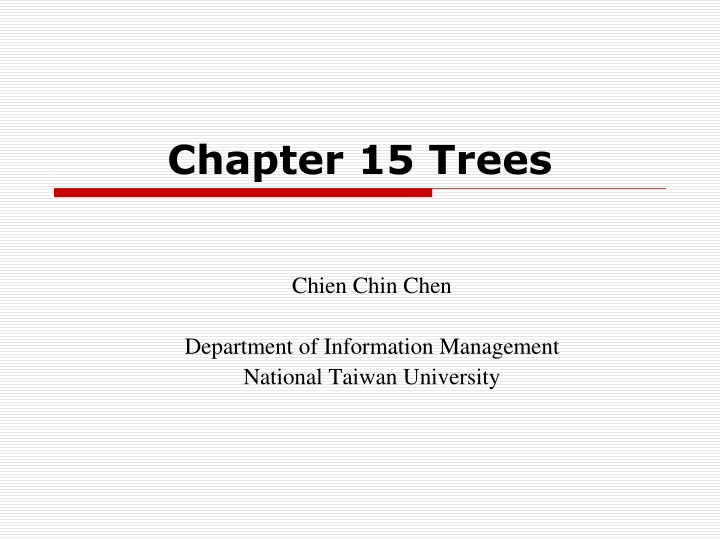
Trees in Data Management: Terminology and Types
Explore the significance of trees in data management as we delve into the terminology, categories of data operations, and different kinds of trees such as binary trees and n-ary trees. Understand the hierarchical nature of trees and their applications in real-world scenarios.
Download Presentation

Please find below an Image/Link to download the presentation.
The content on the website is provided AS IS for your information and personal use only. It may not be sold, licensed, or shared on other websites without obtaining consent from the author. If you encounter any issues during the download, it is possible that the publisher has removed the file from their server.
You are allowed to download the files provided on this website for personal or commercial use, subject to the condition that they are used lawfully. All files are the property of their respective owners.
The content on the website is provided AS IS for your information and personal use only. It may not be sold, licensed, or shared on other websites without obtaining consent from the author.
E N D
Presentation Transcript
Chapter 15 Trees Chien Chin Chen Department of Information Management National Taiwan University
Categories of Data- Management Operations (1/2) ADT operations fit into at least one of these categories: Insert data into a data collection. Delete data from a data collection. Ask questions about the data in a data collection. Position-oriented ADTs: Operations that Insert data into the ith position Delete data from the ith position Ask a question about the data in the ith position Examples: list, stack, queue. Value-oriented ADTs: Operations that Insert data according to its value. Delete data knowing only its value. Ask a question about data knowing only its value. Examples: sorted list. 2
Categories of Data- Management Operations (2/2) In this chapter, we talk about Tree , a very useful ADT in many real-world applications. Position-oriented ADT: binary tree. Value-oriented ADT: binary search tree. 3
Terminology (1/3) Trees are composed of nodes (vertex) and edges. Trees are hierarchical. Parent-child relationship between two nodes. E.g., B and C are children of A. Each node in a tree has at most one parent. Except root, has no parent. E.g., A. A node that has no children is called a leaf of the tree. E.g., C, D, E, F. 4
Terminology (2/3) Sibling relationship: children of the same parent. E.g., B and C. Ancestor-descendant relationships among nodes. A is an ancestor of D. D is a descendant of A. The root of any tree is an ancestor of every node in that tree. Subtree of a tree: Any node and its descendants. A subtree example. 5
Terminology (3/3) The hierarchical property of tree: Can be used to represent information that itself is hierarchical in nature. E.g., organization chart or family tree 6
Kinds of Trees A general treeT is a set of one or more nodes such that T is partitioned into disjoint subsets: A single node r, the root. Sets that are general trees, called subtrees of r. An n-ary tree T is a set of nodes that is either empty or partitioned into disjoint subsets: A single node r, the root. npossibly empty sets that are n-ary subtrees of r. An example of 3-ary tree 7
A Binary Tree (1/2) A binary tree is a set T of nodes such that either: T is empty, or T is partitioned into disjoint subsets: A single node r, the root. Two possibly empty sets that are binary trees, called the left subtree of r and the right subtree of r. Each node in a binary tree Has no more than two children 8
A Binary Tree (2/2) You can use binary trees to represent algebraic expressions. Leafs are operands. Evaluation manner: bottom-up. The hierarchy specifies an unambiguous order for evaluating an expression. Parentheses do not appear in these tree. 9
A Binary Search Tree A binary search tree is a binary tree. But has the following properties for each node n: n s value is > all values in n s left subtree TL. n s value is < all values in n s right subtree TR. Both TL and TR are binary search trees. 10
The Height of Trees (1/3) Height of a tree: Number of nodes along the longest path from the root to a leaf. Height 3 Height 5 Height 7 11 Trees with the same nodes but different heights.
The Height of Trees (2/3) Level of a node n in a tree T: If n is the root of T, it is at level 1. If n is not the root of T, its level is 1 greater than the level of its parent. Level 1 Level 2 Level 3 12
The Height of Trees (3/3) Height of a tree T defined in terms of the levels of its nodes. If T is empty, its height is 0. If T is not empty, its height is equal to the maximum level of its nodes. A recursive definition of height If T is empty, its height is 0 If T is not empty, height(T) = 1 + max{height(TL), height(TR)} / \ TL r TR 13
Full Binary Trees A binary tree of height h is fullif Nodes at levels < h have two children each. Recursive definition: If T is empty, T is a full binary tree of height 0. If T is not empty and has height h > 0, T is a full binary tree if root s subtrees are both full binary trees of height h 1. 14
Complete Binary Trees (1/2) A binary tree of height h is complete if It is full to level h 1. Level h is filledfrom left to right. 15
Complete Binary Trees (2/2) Another definition: A binary tree of height h is complete if All nodes at levels <= h 2 have two children each, and. When a node at level h 1 has children, all nodes to its left at the same level have two children each. When a node at level h 1 has one child, it is a left child. Level 1 Level 2 Level 3 Level 4 Level 5 16
Balanced Binary Trees A binary tree is balanced if the heights of any node s two subtrees differ by no more than 1 Complete binary trees are balanced. Full binary trees are complete and balanced. balanced unbalanced 17
The Maximum Height of a Binary Tree The maximum height of an n-node binary tree is n. By giving each internal node exactly one child. 18
The Minimum Height of a Binary Tree (1/2) To minimize the height of a binary tree given n nodes, you must fill each level of the tree as completely as possible. 19 Counting the nodes in a full binary tree of height h
The Minimum Height of a Binary Tree (2/2) The minimum height of a binary tree with n nodes is log2(n+1) Complete trees and full trees have minimum height. 20
The ADT Binary Tree As an abstract data type, the binary tree has operations that: Add and remove nodes Set or retrieve the data in the root of the tree Test whether the tree is empty Traversal operations that visit every node in a binary tree Visit doing something with or to the node. 21
Traversals of a Binary Tree (1/6) A traversal visits each node in a tree. You do something with or to the node during a visit. For example, display or modify the data in the node. Assume that visiting means displaying data. With the recursive definition of a binary tree, you can construct a recursive traversal algorithm. If the tree is not empty, the traversal algorithm must perform three tasks: Display the data in the root. Traverse the two subtrees (recursive smaller problems). The base case: If the tree is empty, the algorithm takes no action. 22
Traversals of a Binary Tree (2/6) The algorithm has three choice of when to visit the root. Preorder traversal Visit root before visiting its subtrees. i.e., Before the recursive calls. Inorder traversal Visit root between visiting its subtrees. i.e., Between the recursive calls. Postorder traversal Visit root after visiting its subtrees. i.e., After the recursive calls. 23
Traversals of a Binary Tree (3/6) The pseudo code of the preorder traversal algorithm: preorder(binTree: Binarytree): void if(binTree is not empty) { Visit the root of binTree preorder(Left subtree of binTree s root) preorder(Right subtree of binTree s root) } // end if 60 Preorder: 60 20 10 40 30 50 70 20 70 10 40 24 30 50
Traversals of a Binary Tree (4/6) The pseudo code of the postorder traversal algorithm: postorder(in binTree:Binarytree): void if(binTree is not empty) { postorder(Left subtree of binTree s root) postorder(Right subtree of binTree s root) Display the data in the root of binTree } // end if 60 Postorder: 10 30 50 40 20 70 60 20 70 10 40 25 30 50
Traversals of a Binary Tree (5/6) Each of these traversals visits every node in a binary tree exactly once. n visits occur for a tree of n nodes. Each visit performs the same operations on each node, independently of n. It must be O(1). Thus, each traversal is O(n). 26
Traversals of a Binary Tree (6/6) The task of tree traversal can be more than to display each item when you visit it. Copy the item or even alter it. Thus, you might devise many different traversal operations: preorderTraverseAndDisplay, preorderTraverseAndCopy, A better solution: devise a traversal operation can call a function to perform a task on each item in the tree. Function of displaying, copying, or altering items. The client defines and passes this function as an argument to the traversal operation. For instance: bintree.preorderTraverse(display); Next chapter will discuss the implementation details. 27
Binary Tree Operations (1/5) ADT design: Operations: Task: Tests whether this binary tree is empty. Input: None. Output: True if the binary tree is empty; otherwise false. isEmpty() Task: Gets the height of this binary tree. Input: None. Output: The height of the binary tree. getHeight() Task: Gets the number of nodes in this binary tree. Input: None. Output: The number of nodes in the binary tree. getNumberOfNodes() 28
The ADT Binary Tree (2/5) Task: Gets the data that is in the root of this binary tree. Input: none. Output: The root s data getRootData() Task: Replaces the data item in the root of this binary tree with newData, if the tree is note empty. However, if the tree is empty, inserts a new root node whose data item is newData into the tree Input: newData is the data item. Output: None. Task: Adds a new node containing a given data item into this binary tree. Input: newData is the data item. Output: True if the addition is successful, or false if not. setRootData(newData) add(newData) The specification of add is intentionally vague, and gives the programmer flexibility. 29
The ADT Binary Tree (3/5) Task: Removes the node containing the given data item from this binary tree. Input: data is the data item. Output: True if the removal is successful, or false if not. Task: Removes all nodes from this binary tree. Input: None. Output: None. (The tree is empty.) remove(data) clear() Task: Gets a specific entry in this binary tree. Input: anEntry is the desired data item. Output: The entry in the binary tree that matches anEntry. Throws an exception if the entry is not found. getEntry(anEntry) 30
The ADT Binary Tree (4/5) Task: Tests whether the given data item occurs in this binary tree. Input: data is the data item. Output: True if the binary tree contains the given data item, or false if not. Task: Traverses this binary tree in preorder/inorder/postorder and calls the function visit once for each node. Input: visit is a client-defined function that performs an operation on or with the data in each visited node. Output: None. contains(data) preorderTraverse(visit) inorderTraverse(visit) postorderTraverse(visit) 31
The ADT Binary Tree (5/5) UML diagram for the class BinaryTree 32
An Interface Template for the ADT Binary Tree (1/4) #ifndef _BINARY_TREE_INTERFACE #define _BINARY_TREE_INTERFACE template<class ItemType> class BinaryTreeInterface { public: /** Tests whether this binary tree is empty. @return True if the binary tree is empty, or false if not. */ virtual bool isEmpty() const = 0; /** Gets the height of this binary tree. @return The height of the binary tree. */ virtual int getHeight() const = 0; /** Gets the number of nodes in this binary tree. @return The number of nodes in the binary tree. */ virtual int getNumberOfNodes() const = 0; 33
An Interface Template for the ADT Binary Tree (2/4) /** Gets the data that is in the root of this binary tree. @pre The binary tree is not empty. @post The root s data has been returned, and the binary tree is unchanged. @return The data in the root of the binary tree. */ virtual ItemType getRootData() const = 0; /** Replaces the data item in the root of this binary tree with the given data, if the tree is not empty. However, if the tree is empty, inserts a new root node containing the given data into the tree. @pre None. @post The data in the root of the binary tree is as given. @param newData The data for the root. */ virtual void setRootData(const ItemType& newData) = 0; /** Adds a new node containing the given data to this binary tree. @param newData The data for the new node. @post The binary tree contains a new node. @return True if the addition is successful, or false not. */ virtual bool add(const ItemType& newData) = 0; 34
An Interface Template for the ADT Binary Tree (3/4) /** Removes the node containing the given data item from this binary tree. @param data The data value to remove from the binary tree. @return True if the removal is successful, or false not. */ virtual bool remove(const ItemType& data) = 0; /** Removes all nodes from this binary tree. */ virtual void clear() = 0; /** Gets a specific entry in this binary tree. @post The desired entry has been returned, and the binary tree is unchanged. If no such entry was found, an exception is thrown. @param anEntry The entry to locate. @return The entry in the binary tree that matches the given entry. @throw NotFoundException if the given entry is not in the tree. */ virtual ItemType getEntry(const ItemType& anEntry) const throw(NotFoundException) = 0; 35
An Interface Template for the ADT Binary Tree (4/4) /** Tests whether a given entry occurs in this binary tree. @post The binary search tree is unchanged. @param anEntry The entry to find. @return True if the entry occurs in the tree, or false if not. */ virtual bool contains(const ItemType& anEntry) const = 0; /** Traverses this binary tree in preorder (inorder, postorder) and calls the function visit once for each node. @param visit A client-defined function that performs an operation on or with the data in each visited node. */ virtual void preorderTraverse(void visit(ItemType&)) const = 0; virtual void inorderTraverse(void visit(ItemType&)) const = 0; virtual void postorderTraverse(void visit(ItemType&)) const = 0; }; // end BinaryTreeInterface #endif 36
The ADT Binary Search Tree The ADT binary search tree is suitable for searching a tree for a particular data item. For each node n in a binary search tree: n s value is greater than all values in its left subtree TL. n s value is less than all values in its right subtree TR. Both TL and TR are binary search tres. This organization of data enables you to search a binary search tree for a particular data item efficiently. 37
Binary Search Tree Operations (1/2) As an ADT, the binary search tree has operations of inserting, removing, and retrieving data. Unlike the position-oriented ADTs stack, list, and queue, but like the ADT sorted list, the insertion, removal, and retrieval operations are by value, not by position. The traversal operations that you just saw for a binary tree apply to a binary search tree without change. Because a binary search tree is a binary tree!! 38
Binary Search Tree Operations (2/2) ADT design: Operations: Task: Inserts newEntry into this binary search tree such that the properties of a binary search tree are maintained. Input: newEntry is the data item to be inserted. Assumes the entries in the tree are distinct and differ from newEntry Output: True if the insertion is successful, or false if not. Task: Removes the given entry from this binary search tree such that the properties of a binary search tree are maintained. Input: anEntry is the entry to remove. Output: True if the removal is successful, or false if not. add(newEntry) remove(anEntry) The methods isEmpty, getHeight, getNumberOfNodes, getRootData, clear,getEntry, contains, preorderTraverse, inorderTraverse, and postorderTraverse have the same specifications as for a binary tree. 39
ADT Binary Search Tree: Search Algorithm (1/4) Because a binary search tree is recursive by nature, it is natural to formulate recursive algorithms for operations on the tree. search(bstTree: BinarySearchTree, target: ItemType) if (bstTree is empty) The desired item is not found else if (target == data item in the root of bstTree) The desired item is found else if(target < data item in the root of bstTree) search(Left subtree of bstTree, target) else // searchKey > root item search(Right subtree of bstTree, target) 40
ADT Binary Search Tree: Search Algorithm (2/4) Suppose you want to locate Elisa s record in the binary tree. Elisa< Jane Jane Elisa > Bob Bob Tom Alan Elisa Nancy Wendy Elisa == Elisa bingo 41
ADT Binary Search Tree: Search Algorithm (3/4) As you will see, this search algorithm is the basis of the other operations on a binary search tree!! Note that the shape of the tree in no way affects the validity of the search algorithm. However, the search algorithm works more efficiently on some trees than on others!! 42
ADT Binary Search Tree: Search Algorithm (4/4) The shape of a binary search tree affects the efficiency of its operations. The more balanced a binary search tree is, the farther it is from a linear structure. The behavior of the search algorithm will be to a binary search of an array!! 43
ADT Binary Search Tree: Insertion (1/2) Suppose that you want to insert a record for Frank into the binary search tree. Imagine that you instead want to search for the item with Frank. Frank must be the right child of Elisa!! Jane Bob Tom Alan Elisa Nancy Wendy Frank 44
ADT Binary Search Tree: Insertion (2/2) Search always tells you the insertion point. It will always terminate at an empty subtree. Or search always tells you to insert the item as a new leaf!! 45
ADT Binary Search Tree: Traversal Traversals for a binary search tree are the same as the traversals for a binary tree. The inorder traversal of a binary search tree visits the tree s nodes in sorted search-key order. 46
The Efficiency of Binary Search Tree Operations (1/7) Each operation compares the a specified value v to the entries in the nodes along a path through the tree. Start at the root. Terminate at the node that contains v (or an empty subtree). Elisa < Jane Jane Elisa > Bob Bob Tom Alan Elisa Nancy Wendy Elisa == Elisa bingo 47 3 comparisons
The Efficiency of Binary Search Tree Operations (2/7) Thus, the efficiency of each operation is related (proportional) to the number of nodes along the comparison path. The maximum number of comparisons is the number of nodes along the longest path from root to a leaf that is, the tree s height. 48
The Efficiency of Binary Search Tree Operations (3/7) However, several different binary search trees are possible for the same data!! To locate Wendy : Alan Jane Bob Elisa Tom Bob Jane Alan Elisa Nancy Wendy Nancy 3 comparisons 7 comparisons!! Tom Wendy 49
The Efficiency of Binary Search Tree Operations (4/7) The order in which insertion and deletion operations are performed on a binary search tree affects its height. Now, we try to analyze the maximum and minimum heights of a binary search tree with n nodes. The maximum height of a binary tree with n nodes is n. By giving each internal node exactly one child. 50




